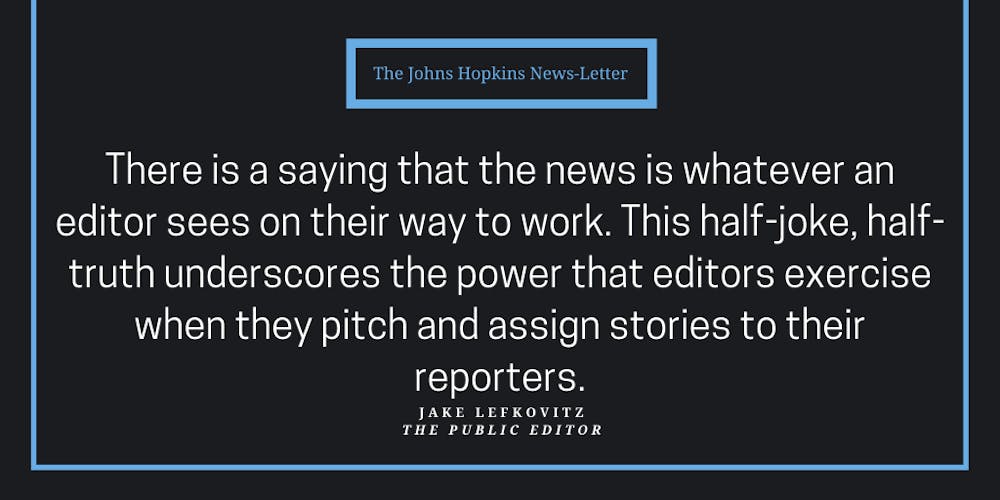
Editor’s Note: This article, filed August 26, discusses some of the reporting efforts that went into the August 27 article “No updates on Stieff Silver building noose incident after a month.”
Reader and recent alum Ifeyinwa Egbunike reached out to me on August 12, wanting to know why there had been no News-Letter coverage of University President Ronald J. Daniels’ announcement on July 3 that someone had discovered a noose in University-owned property near campus.
In a subsequent interview, she told me that this felt to her like part of a larger trend.
“I feel that a lot of times in News-Letter coverage, sometimes things that the Black community is experiencing or things that the Black community are a part of kind of just get swept under the rug or aren’t really talked about,” she said.
To figure out what happened in this instance, I spoke with News & Features Editors Michelle Limpe and Chris Park, as well as Editor-in-Chief Rudy Malcom.
What they all told me was that this lack of coverage was an oversight, one caused by the difficulties that the new staff — not all of whom are currently in the U.S. — faced reporting over the summer, when typically The News-Letter does not publish.
“The reason that the piece wasn’t published was not purposeful. Katy and I explicitly conveyed multiple times that we wanted a piece about this,” Malcom said, referring to his fellow Editor-in-Chief Katy Wilner.
Limpe and Park told me that by around July 8 they had written an article on the incident in response to a request by the Editors-in-Chief. At around 550 words, this article was short. But not unusually short for a piece written largely off an email from the administration.
It included material from only a small number of interviews with sources — only three — all of whom were students without much additional knowledge of the incident. Limpe and Park interviewed them for their reactions. Official sources, like the Office of Institutional Equity, had either declined to comment or not responded at all. Again, this would not be unusual for a piece of this kind.
For the Editors-in-Chief, however, this was too little and too late, Malcom told me.
“It wouldn’t have at that point been adding anything new to the conversation since the piece was unfortunately already delayed. We should have had a piece sooner, but because at that point it hadn’t happened we decided not to run one. We said that there could be a piece once there was an update,” he said.
That update came on July 27, when a quartet of senior administrators sent out another email.
They wrote that the investigations were ongoing, that they were restarting work at the job site where the noose had been found, that they had worked with the relevant contractor to strengthen their anti-discrimination and anti-harassment procedures, and that were reviewing the same procedures of all University contractors.
Malcom told me that he and Wilner asked Limpe and Park to prepare the article for publication after this email. Limpe and Park said that they tried to interview more people, but no one in the group of about four people that they reached out to was willing.
Uncertain what else they could do, they told me, they did not resubmit the article to the Editors-in-Chief for publication or ask for help. Instead, they figured that they would wait, in case some of the sources they had previously contacted would respond. Meanwhile, Malcom and Wilner waited for them to submit their piece but did not follow up.
That is what I was told happened.
Everyone involved told me that they were sorry that this had happened and that they would try to ensure that it would not happen again. The beginning of the semester and the return to a more normal production cycle should help, they said.
And Malcom said that it was these kinds of issues which he hopes will be addressed by the diversity and inclusion panel which he and Wilner will be leading.
He told me that this panel will meet to provide feedback on The News-Letter’s coverage, identify ways to recruit more Black staff members and staff members of color, and recommend relevant training.
I think that this is certainly a welcome step. I think that there are also other initiatives which could further increase The News-Letter’s accountability for better covering Black life on campus, as well as improve the paper’s overall coverage.
One of the most powerful journalistic innovations of the early 20th century was the idea of the beat. It was made possible by the telephone, which allowed a reporter to spend most of their day outside the office, periodically calling information into the newsroom where it would be written up into a story, as journalist and writer James McGrath Morris told WNYC’s On The Media in 2014.
This transition to beat reporting did two things.
It meant that journalists began developing expertise in the things which they covered. Spending day after day out on their beats, they got to know the usual rhythms of life there and built trust with the people who set those rhythms. As a result, the journalists got better at picking out the important stories and telling them well.
Along with developing journalists’ expertise, beat reporting gave the public more ways to participate in the journalistic process. If someone appreciated a reporter’s coverage and wanted to help that reporter with a story, it was easy for that person to find them. And if someone was unhappy with that reporter’s coverage and wanted to set that reporter straight, it was equally easy for that person to find them.
Right now, The News-Letter does divide its reporting staff between the different sections like News & Features, Sports, Science & Technology, Leisure and Arts & Entertainment. But aside from these broad divisions, there are no formal, specialized beats.
News-Letter reporters will often be eager to cover certain kinds of stories. But they usually have to wait for an editor to assign them to those stories. And even after they have done one story, they might not get another assignment like it again for a while. It depends on the editor and what assignments they decide to make.
There is a saying that the news is whatever an editor sees on their way to work. This half-joke, half-truth underscores the power that editors exercise when they pitch and assign stories to their reporters. And also the power that they exercise when they do not.
The promise of beat reporting is that the news becomes more of a partnership between editors, reporters and members of the public. Members of the public can more easily hold editors and reporters accountable for their coverage. And in exchange editors and reporters gain far more opportunities to tell interesting and important stories.
A hypothetical campus race beat would not be a cure-all. It would not relieve other staff members from their duty to see where and how race figures into their coverage and publish stories which reflect that. But it would be a significant investment toward making sure that stories about Black life on campus are consistently told and are told well.
Thank you for reading. This column was possible because of a tip from a reader like you. The Public Editor would love to hear from more of you and have more of your thoughts and concerns guide his writing. If you would like to follow up with the Public Editor about something raised in this column or anything else related to The News-Letter, email him at publiceditor@jhunewsletter.com.





